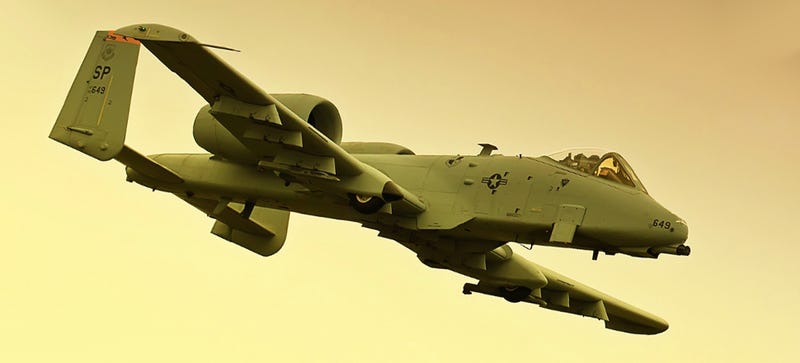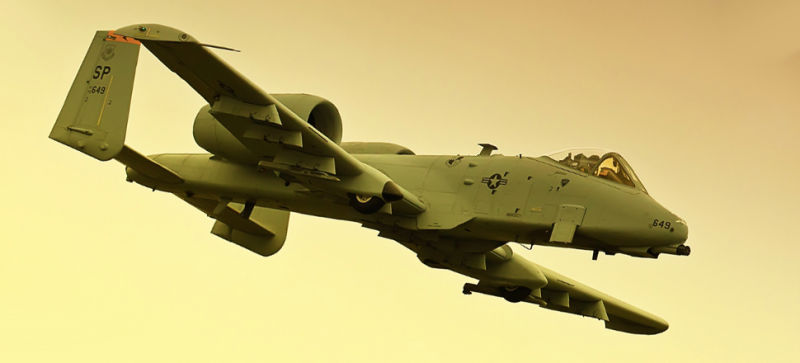
The U.S. Air Force A-10 Thunderbolt II AKA “Warthog” has become one of the most-recognized and beloved warplanes since it started flying in the 1970s. We’ve been hearing about its impending retirement—and the reason many in the armed services community are against that—for ages, but proposed legislation could keep it in the sky for at least a little longer.
http://foxtrotalpha.jalopnik.com/the-air-force-…
This week House Armed Services Committee (HASC) Chairman Rep. Mac Thornberry submitted his latest version of the defense policy bill that would dictate how military money would be spent. Subtitle D, Section 142 of H.R. 1735 basically says the Air Force would not be able to use any fiscal year 2017 funds “to retire, prepare to retire, or place in storage or on backup aircraft inventory status any A–10 aircraft.”
Advertisement
The bill also requires the USAF to keep at least 171 A-10s as “primary mission aircraft inventory;” in other words, ready to rock and roll.
Keeping the Warhog in action per Thornberry’s plan would require $682.7 million, according to Air Force Times. And DoD Buzz says that might mean parking some F-16 fighter jets and delaying the already shaky launch of the F-35 jet.
Sponsored
The F-35 has been plagued with issues for years now, earning it a reputation as an over-budget under performer. Theoretically the F-35 is destined to be a “multi-role” warplane that can do the air-to-air duties of fighters like the F-16 as well as the ground-support duties that the A-10 has set the standard in.
The problem critics have with the F-35 in relation to the A-10 is that the new jet’s value proposition leans on stealth tech and air combat abilities which don’t seem all that relevant in America’s current combat situation against ISIS.
The A-10 has been proving itself as a prime ground-force support vehicle for over four decades, and folks are having a hard time figuring out why a replacement vehicle, that costs $21,000 moreper hour to fly (according toPopular Mechanics) but isn’t necessarily as good at the A-10’s main mission designation, is being considered.
There’s also the emotional attachment to the A-10. I’ve heard of servicemen describing the jet as “a guardian angel” in combat situations, and that’s because the A-10 is basically a flying tank that’s saved many lives with its close air support prowess.
Advertisement

It’s literally airborne armor built around a 4,000 pound cannon that can unleash a hail of 30mm rounds at a terrifyingly fast rate of 3,900 per minute. The flat wing design lets it stay low-but-aloft for long periods of time, the rear-mounted engines are supposed to be harder to hit from the ground, and redundancies allow for extreme survivability when it takes a beating.
So that’s what’s at stake as Thornberry pushes the National Defense Authorization Act for Fiscal Year 2016. Now as to the likelihood of his success, things look murky as Defense Secretary Ash Carter has absolutely nothing nice to say about it at all.
“It’s another road to nowhere, with uncertain chances of ever becoming law, and a high probability of leading to more gridlock and another continuing resolution — exactly the kind of terrible distraction we’ve seen for years, that undercuts stable planning and efficient use of taxpayer dollars, dispirits troops and their families, baffles friends, and emboldens foes,” as Defense News quotes Carter. “I cannot support such maneuvers as secretary of defense.”
Against the A-10 specifically, the Air Force says it can save taxpayers $4.2 billion with their plan to pair down their fleet of these jets over the next few years, reports DoD Buzz.
As it stands, the Air Force is currently planning to start shutting down their A-10’s in the 2018 fiscal year, with the last one scrapped in the 2022 fiscal year. Whether or not we really only have five or so years left with the aircraft depends on legislation like H.R. 1735, the military’s budget, our next president and of course the actual viability of a suitable replacement vehicle.
“Rigorous oversight, endorsements from soldiers and Marines about the protection only the A-10 can provide, and repeated deployments in support of OIR (Operation Inherent Resolve in Iraq and Syria) have persuaded Chairman Thornberry and many members from both parties that the budget driven decision to retire the A-10 is misguided,” argues the HASC.
Even though Thornberry’s bill only seems to protect the A-10 through the end of the year, its allocation of money to its maintaining and upgrading could pave a path to keeping it fighting for longer.
As to the F-35 as an honest replacement, the military and American public are still waiting for better performance out of prototypes.
Hat tip to 900Turbo!













